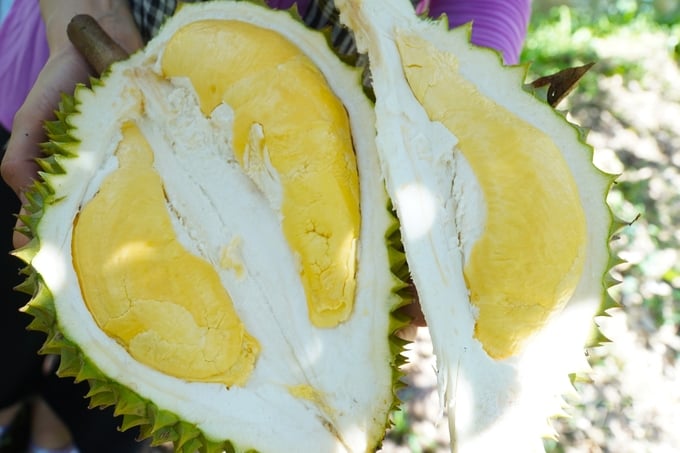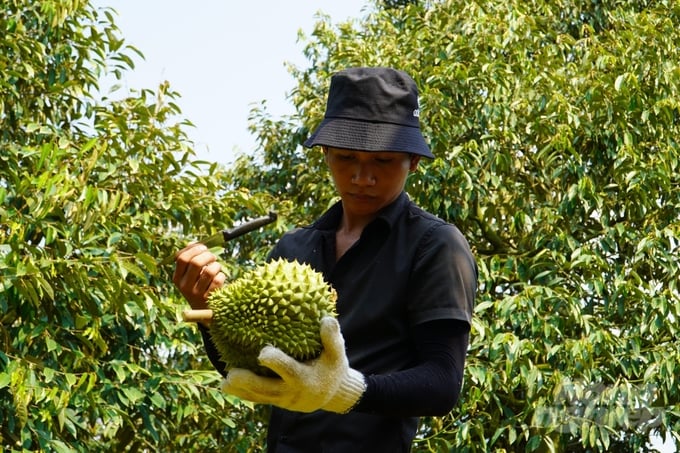November 19, 2025 | 02:38 GMT +7
November 19, 2025 | 02:38 GMT +7
Hotline: 0913.378.918
November 19, 2025 | 02:38 GMT +7
Hotline: 0913.378.918
On July 11, 2022, Vietnam's Ministry of Agriculture and Rural Development (MARD) and the General Administration of Customs of China (GACC) signed a protocol on phytosanitary requirements for fresh durian exported to China.
As a result, in 2022, Vietnam's durian exports reached $ 421 million. By 2023, durian exports had exceeded $ 2.2 billion, an increase of 430% compared to 2022.

The Vietnam Fruit and Vegetable Association (Vinafruit) estimates that in 2024, the export value of Vietnamese durian could reach between $3 billion and $3.5 billion. Photo: Minh Dam.
It is projected that in 2024, the export value of durian will reach between $ 3 billion and $ 3.5 billion, following the signing of a protocol by China's General Administration of Customs on August 19 regarding the inspection, quarantine, and food safety requirements for Vietnamese frozen durian exported to China.
Mr Dang Phuc Nguyen, General Secretary of the Vietnam Fruit and Vegetable Association, stated that besides the Chinese market, Vietnamese durian has been exported to other countries such as the United States, the EU, Japan, and Australia, either as whole frozen fruits or separated segments.
Previously, using traditional compressor-based freezing methods, it took an average of 6 to 8 hours to freeze a 40-foot container to -18°C. Nowadays, with a new freezing system utilizing liquid nitrogen technology, achieving -18°C takes only about 1 hour, significantly faster.
However, the current and upcoming supply of liquid nitrogen, along with the accompanying technology and equipment, will pose a significant challenge as the export volume of frozen durian to the Chinese market and other countries increases sharply, competing with Thai products that predominantly use nitrogen for durian freezing.

After thawing, the flavour of the durian remains exactly the same as fresh durian, ensuring 100% retention of its quality and taste. Photo: Kim Anh.
"Malaysia has previously faced difficulties due to a shortage of nitrogen supply for freezing durians intended for export, as they were only allowed to export frozen durian to China. Therefore, Vietnamese businesses should consider and pay attention to this issue when exporting frozen durian to China," Mr. Nguyen noted.
In the Mekong Delta region, there are still instances where farmers and traders, driven by quantity and the desire for higher prices, intentionally harvest some fruits before they reach full ripeness.
Mr. Nguyen emphasized that this is extremely dangerous for the Vietnamese durian industry as a whole, affecting both the brand of businesses and the national brand of Vietnam. Hence, there must be strict control measures, penalties, or the implementation of stringent "regulations" to severely punish the harvesting of unripe durians for export.
Moreover, it is crucial to establish a national standard immediately. This standard should clearly define the criteria for fresh and frozen export durian, including fibre content, dryness, and Brix level for each durian variety so that the authorities can accurately and objectively assess quality.
Additionally, the regulations should specify which durian varieties are permitted for export, such as the popular Dona and Ri6 varieties, to protect Vietnam's national brand and prevent the widespread export of untrustworthy varieties.

The process of checking the quality and ripeness of Vietnamese durians remains limited, relying on rudimentary tools like simple tapping instruments. Photo: Kim Anh.
Furthermore, traders purchasing durians, including companies specializing in packaging, are currently facing a shortage of skilled workers capable of selecting and classifying fruits by ripeness. The selection process is still very manual, using basic tools like tapping to determine the ripeness of the fruit.
In contrast, developed countries have already equipped themselves with advanced machinery and infrared technology to select fruits like lemons, oranges, tangerines, grapefruits, and acerola cherries for export. Therefore, Mr Nguyen suggested that the agricultural sector should organize training courses on durian cultivation and care according to GAP standards for farmers, as well as techniques for sorting and packaging for export companies. It might even be necessary to issue professional certification for workers involved in tapping and sorting fruits to enhance the quality of durians.
Regarding the issuance of planting area codes and packaging facility codes, while efforts have been made to expedite the process, it still lags behind the demand and production scale of Vietnam. As of now, the country has over 700 planting area codes and 168 packaging facilities that meet the requirements for export to the Chinese market. In the last months of 2024, when production and export values are expected to rise even further, this could pose challenges for the industry.
Translated by Hoang Duy

(VAN) Deputy Prime Minister Tran Hong Ha convened a meeting with the MAE and relevant agencies to discuss the draft decree on national multidimensional poverty standards for the 2026 - 2030 period.

(VAN) The year 2025 marks the 10th anniversary since more than 190 countries adopted the Paris Agreement on climate change, paving the way for strengthened global action.

(VAN) The PepsiCo Foundation funded the project ‘New Harvest: Sustainable Agriculture Initiative’, focusing on regenerative agriculture and climate change.

(VAN) Dr. Nguyen Viet Hung, ILRI's Regional Director for Asia, emphasized the One Health approach in ensuring food safety and reducing antimicrobial resistance risks in livestock.

(VAN) The youth-driven initiative ‘Innovate for water, act for the future’ seeks practical, scalable solutions to Vietnam’s water challenges.

(VAN) At the Annual Science Conference of Thuyloi University, Deputy Minister Phung Duc Tien directed researchers to focus on in-depth studies, data harmonization, and solutions linked to real-world practice.

(VAN) After nearly four years of implementation, 5,187 community agricultural extension groups have been established nationwide, with 47,493 members participating.